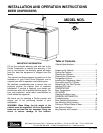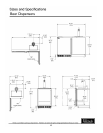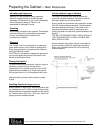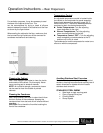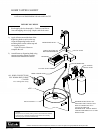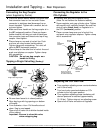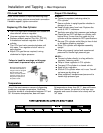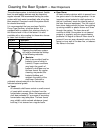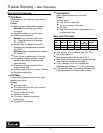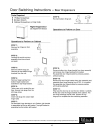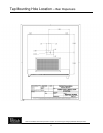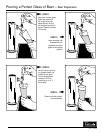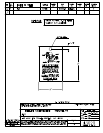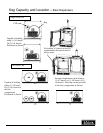
Installation and Tapping – Beer Dispensers
CO2 Leak Test
Dilute a small amount of liquid dishwashing soap
and rub the soapy mixture around each connection.
If bubbles appear, tighten connection.
Replacing CO2 Gas Cylinder
■
Turn CO
2 hand valve clockwise until seated and
close shut-off valve on regulator.
.
Proper CO2 Handling
ALWAYS...
■
Connect a regulator (reducing valve) to
CO
2 cylinder.
■
Secure cylinder in upright position whether in
storage or in use.
■
Keep cylinder away from heat. Rupture disc
vents at 122° F. maximum.
■
Ventilate room after high pressure gas leakage.
■
Check the last DOT test date on cylinder neck
before filling. If more than five years old, the
cylinder must be retested to DOT specifications.
■
Be sure CO2 cylinder outlet fitting is free of dust
or dirt before attaching regulator.
■
Store CO2 cylinder and regulator assembly
upright.
■
Allow only properly trained and experienced
personnel to handle high pressure gas.
Beverage systems pressur-
ized with carbon dioxide or
nitrogen must be equipped
with two safety relief
valves; one at the cylinder
regulator and the other in
the gas line upstream on
the product tanks.
■
Unscrew regulator from cylinder fitting.
■
Replace carbonic washer (Part No. 157F2P),
if needed and reattach regulator to filled
cylinder.
■
Turn CO2 hand valve counterclockwise until
fully open. Turn regulator shut-off valve to
open position.
■
Adjust CO2 gas flow as required, turning
clockwise for higher pressure.
NEVER...
■
Connect cylinder directly to a keg without a
regulator (reducing valve).
■
Drop or throw regulator or CO2 cylinder.
■
Transport CO2 cylinder in a closed vehicle.
■
Apply oil to a regulator.
■
Shut off CO2 cylinder when not in use. You will
not save gas by doing so!
■
Allow untrained, inexperienced personnel to
handle high pressure gas.
.
.
Failure to heed the warnings on this page
could result in personal injury or death.
Temperature
One of the most common causes of dispensing
problems is improper temperature. Draft beer
should be stored at a temperature between 32° and
38°. At warmer temperatures, beer will foam.
At temperatures lower than 30° F., beer will freeze.
When beer freezes, the alcohol in the beer may
separate and cause the beer to be cloudy with an
“off” taste.
7
Perlick is committed to continuous improvement. Therefore, we reserve the right to change specifications without prior notice.



